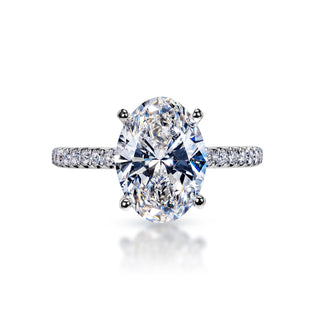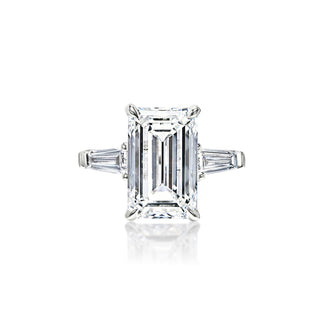Why Choose Lab-Grown Diamonds for Your Engagement Ring?
Share
Lab-grown diamonds have been making waves in the jewelry industry, presenting a modern, sustainable alternative to traditional earth-mined diamonds. These gems are identical in appearance and quality to natural diamonds but come with several distinct advantages. As you explore your options for the perfect engagement ring, it's worth considering what lab-grown diamonds have to offer. With Mike Nekta's expertise as a third-generation diamond expert and a Gemological Institute of America graduate, you’re in good hands. Let’s dive into why lab-grown diamonds might be the right choice for your engagement ring.

What exactly are lab-grown diamonds? How are they created?
Lab-grown diamonds, sometimes called synthetic or cultured diamonds, are created in controlled laboratory environments using advanced technological processes. They are made from the same carbon atoms as natural diamonds, arranged in the same crystal structure. The two primary methods for creating lab-grown diamonds are High Pressure High Temperature (HPHT) and Chemical Vapor Deposition (CVD). Both methods result in diamonds that are virtually indistinguishable from natural diamonds in terms of chemical composition, physical properties, and visual appearance.
Are lab-grown diamonds real diamonds? How do they compare to natural diamonds in terms of quality and appearance?
Yes, lab-grown diamonds are real diamonds. They share the same physical, chemical, and optical properties as earth-mined diamonds. When it comes to quality and appearance, lab-grown diamonds are virtually identical to their natural counterparts. They exhibit the same brilliance, fire, and sparkle. The main differences are their origin and the absence of the environmental and ethical issues associated with traditional diamond mining.
What are the advantages of choosing a lab-grown diamond for an engagement ring?
Lab-grown diamonds offer several compelling benefits for engagement rings:
- Cost-Effective: Lab-grown diamonds typically cost 30-40% less than natural diamonds. This allows you to get a larger or higher-quality stone within your budget.
- Ethical and Sustainable: Choosing lab-grown diamonds means avoiding the environmental damage and ethical concerns associated with diamond mining. This includes issues like habitat destruction and unfair labor practices.
- Identical Beauty: Lab-grown diamonds look identical to natural diamonds, offering the same brilliance and sparkle that make diamonds so desirable.
How much can you save by choosing a lab-grown diamond over a natural diamond?
One of the biggest advantages of lab-grown diamonds is their affordability. Because they are created in a controlled environment, the costs associated with mining, transporting, and cutting natural diamonds are eliminated. As a result, lab-grown diamonds are generally 30-40% less expensive than their earth-mined counterparts. This means you can afford a larger or higher-quality stone for the same price, making your engagement ring even more impressive.

What are the sustainability and ethical advantages of lab-grown diamonds?
Lab-grown diamonds are a more ethical and sustainable choice. Traditional diamond mining can have significant environmental impacts, including habitat destruction, soil erosion, and water pollution. Additionally, the diamond mining industry has a history of human rights abuses and unfair labor practices. By choosing lab-grown diamonds, you can be confident that your gem was produced in an environmentally friendly and ethically sound manner.
What should you consider when choosing a lab-grown diamond for an engagement ring?
When selecting a lab-grown diamond for your engagement ring, consider the same criteria as you would for a natural diamond. The 4C’s – cut, color, clarity, and carat weight – are essential factors to evaluate:
- Cut: A well-cut diamond will have superior brilliance and sparkle.
- Color: Lab-grown diamonds come in various colors, but the most valuable are those with the least color.
- Clarity: Higher clarity diamonds have fewer inclusions and blemishes.
- Carat Weight: This measures the diamond's size. Lab-grown diamonds allow you to afford larger stones within your budget.
How can you personalize a lab-grown diamond engagement ring?
Yes, lab-grown diamond engagement rings can be customized just like natural diamond rings. You can choose the diamond’s cut, color, clarity, and carat weight, and select a setting that complements the stone. Mike Nekta specializes in creating custom designs, allowing you to create a one-of-a-kind ring that reflects your personal style and preferences.
How should you care for and maintain your lab-grown diamond jewelry?
Caring for lab-grown diamonds is similar to caring for natural diamonds. Here are some tips to keep your jewelry sparkling:
- Regular Cleaning: Clean your diamond jewelry regularly using a gentle solution of mild dish soap and warm water. Use a soft brush to remove any dirt or residue.
- Professional Check-ups: Have your jewelry inspected by a professional jeweler periodically to ensure the settings are secure and the diamonds are in good condition.
- Safe Storage: Store your diamond jewelry in a soft pouch or a jewelry box to prevent scratches and damage.
Conclusion
Choosing a lab-grown diamond for your engagement ring offers numerous benefits, including affordability, ethical considerations, and sustainability. With identical beauty and quality to natural diamonds, lab-grown diamonds are a smart choice for many couples. Mike Nekta’s expertise in creating high-quality, certified lab-grown diamond jewelry ensures that you’ll find the perfect ring to symbolize your love. Explore the stunning collection or book a consultation to start designing your dream engagement ring today.